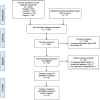Ischemic stroke and intracranial hemorrhage in extracorporeal membrane oxygenation for COVID-19: A systematic review and meta-analysis
- PMID: 36189498
- PMCID: PMC9527229
- DOI: 10.1177/02676591221130886
Ischemic stroke and intracranial hemorrhage in extracorporeal membrane oxygenation for COVID-19: A systematic review and meta-analysis
Abstract
Purpose: Extracorporeal membrane oxygenation (ECMO) is employed to support critically ill COVD-19 patients. The occurrence of ischemic stroke and intracranial hemorrhage (ICH), as well as the implementation of anticoagulation strategies under the dual influence of ECMO and COVID-19 remain unclear. We conducted a systematic review and meta-analysis to describe the ischemic stroke, ICH and overall in-hospital mortality in COVID-19 patients receiving ECMO and summarize the anticoagulation regimens.
Methods: EMBASE, PubMed, Cochrane, and Scopus were searched for studies examining ischemic stroke, ICH, and mortality in COVID-19 patients supported with ECMO. The outcomes were incidences of ischemic stroke, ICH, overall in-hospital mortality and anticoagulation regimens. We calculated the pooled proportions and 95% confidence intervals (CIs) to summarize the results.
Results: We analyzed 12 peer-reviewed studies involving 6039 COVID-19 patients. The incidence of ischemic stroke had a pooled estimate of 2.2% (95% CI: 1.2%-3.2%). The pooled prevalence of ICH was 8.0% (95% CI: 6.3%-9.6%). The pooled estimate of overall in-hospital mortality was 40.3% (95% CI: 33.1%-47.5%). The occurrence of ICH was significantly higher in COVID-19 patients supported with ECMO than in other respiratory ECMO [relative risk=1.75 (95% CI: 1.00-3.07)]. Unfractionated heparin was the most commonly used anticoagulant, and anticoagulation monitoring practice varied among centers.
Conclusions: Ischemic stroke and ICH were common under the double "hit" of COVID-19 and ECMO. The prevalence of ICH was significantly higher in COVID-19 patients supported with ECMO than non-COVID-19 patients requiring ECMO. Individualized anticoagulation regimens may be a good choice to balance thrombosis and bleeding. More detailed research and further exploration are needed to clarify the underlying mechanism and clinical management decisions.
Keywords: COVID-19; anticoagulation; extracorporeal membrane oxygenation; intracranial hemorrhage; ischemic stroke; overall in-hospital mortality.
Conflict of interest statement
Declaration of conflicting interestsThe author(s) declared no potential conflicts of interest with respect to the research, authorship, and/or publication of this article.
Figures





Similar articles
-
Thrombosis and bleeding in patients with COVID-19 requiring extracorporeal membrane oxygenation: a systematic review and meta-analysis.Res Pract Thromb Haemost. 2023 Feb;7(2):100103. doi: 10.1016/j.rpth.2023.100103. Epub 2023 Mar 8. Res Pract Thromb Haemost. 2023. PMID: 36999123 Free PMC article. Review.
-
Intracranial Hemorrhages on Extracorporeal Membrane Oxygenation: Differences Between COVID-19 and Other Viral Acute Respiratory Distress Syndrome.Crit Care Med. 2022 Jun 1;50(6):e526-e538. doi: 10.1097/CCM.0000000000005441. Epub 2022 Jan 12. Crit Care Med. 2022. PMID: 35020672 Free PMC article.
-
Management of Anticoagulation Therapy in ECMO-Associated Ischemic Stroke and Intracranial Hemorrhage.Innovations (Phila). 2023 Jan-Feb;18(1):49-57. doi: 10.1177/15569845221141702. Epub 2023 Jan 11. Innovations (Phila). 2023. PMID: 36628944 Free PMC article.
-
Intracranial hemorrhage in patients treated for SARS-CoV-2 with extracorporeal membrane oxygenation: A systematic review and meta-analysis.J Crit Care. 2023 Oct;77:154319. doi: 10.1016/j.jcrc.2023.154319. Epub 2023 May 11. J Crit Care. 2023. PMID: 37178492 Free PMC article.
-
Prognostic Factors Associated With Intracranial Hemorrhage and Ischemic Stroke During Venovenous Extracorporeal Membrane Oxygenation: A Systematic Review.Crit Care Med. 2025 Feb 1;53(2):e400-e409. doi: 10.1097/CCM.0000000000006520. Epub 2024 Dec 11. Crit Care Med. 2025. PMID: 39660976 Free PMC article.
Cited by
-
Thrombosis and bleeding in patients with COVID-19 requiring extracorporeal membrane oxygenation: a systematic review and meta-analysis.Res Pract Thromb Haemost. 2023 Feb;7(2):100103. doi: 10.1016/j.rpth.2023.100103. Epub 2023 Mar 8. Res Pract Thromb Haemost. 2023. PMID: 36999123 Free PMC article. Review.
-
Lactate Dehydrogenase and Hemorrhagic Stroke During Extracorporeal Membrane Oxygenation for COVID-19.Lung. 2023 Aug;201(4):397-406. doi: 10.1007/s00408-023-00630-w. Epub 2023 Jul 4. Lung. 2023. PMID: 37401936
-
Acute Ischemic Stroke during Extracorporeal Membrane Oxygenation (ECMO): A Narrative Review of the Literature.J Clin Med. 2024 Oct 9;13(19):6014. doi: 10.3390/jcm13196014. J Clin Med. 2024. PMID: 39408073 Free PMC article. Review.
References
-
- Reporting COVID-19 Cases into the ELSO Registry. Available from:https://www.elso.org/COVID19.aspx
Publication types
MeSH terms
Substances
LinkOut - more resources
Full Text Sources
Medical

